Peruvian Lomo Saltado: A Classic Stir-Fry Dish You Need to Try

Peruvian cuisine is a melting pot of flavors and cultures that reflects the country’s history and diversity. One of the most beloved and iconic dishes of Peruvian cuisine is Lomo Saltado, a stir-fry dish that blends the flavors of China and Peru. This mouthwatering dish is a must-try for anyone looking to experience the richness of Peruvian cuisine. Lomo Saltado Recipe: To make Lomo Saltado, you will need the following ingredients: Lomo Saltado Cooking Time: Preparation time: 20 minutes Cooking time: 20 minutes Serving: 4 people Lomo Saltado Instructions: Lomo Saltado is a simple yet flavorful dish that is perfect for a quick weeknight dinner or a weekend get-together. The dish is easy to make and can be adapted to your taste by adding or subtracting ingredients. The beef strips are the star of the dish, and the key to a successful Lomo Saltado is to use high-quality beef that is cut into thin strips. The beef is first stir-fried until browned on all sides, which adds flavor and texture to the dish. The sauce is what brings all the flavors together in Lomo Saltado. The combination of soy sauce, red wine vinegar, beef broth, and cumin powder creates a savory and slightly tangy sauce that complements the beef and vegetables perfectly. Lomo Saltado Tips: One of the unique aspects of Lomo Saltado is the addition of French fries, which might seem odd at first but adds a satisfying crunch to the dish. The fries are traditionally served on top of the stir-fry, but you can also serve them on the side. In addition to the French fries, Lomo Saltado is typically served with white rice. The rice helps to balance out the flavors of the dish and provides a neutral base for the stir-fry. While the recipe for Lomo Saltado is relatively simple, there are a few tips and tricks to keep in mind to ensure that your dish turns out perfectly. First, make sure to use high-quality beef that is cut into thin strips. This will help to ensure that the beef cooks evenly and is tender and juicy. Second, be sure to use a hot pan and stir-fry the beef quickly. This will help to seal in the juices and prevent the beef from becoming tough. Third, don’t be afraid to experiment with the ingredients. While the basic recipe calls for beef, onion, tomatoes, and chili pepper, you can add other vegetables such as bell peppers or green onions for a different flavor profile. Finally, make sure to have all your ingredients prepped and ready to go before you start cooking. Stir-frying is a fast cooking method, and you won’t have time to chop vegetables or measure out ingredients once you start cooking. In addition to being delicious, Lomo Saltado is also a healthy dish. The beef provides protein, while the vegetables add vitamins and minerals. The dish is also low in fat and can be made gluten-free by using tamari sauce instead of soy sauce. In Peru, Lomo Saltado is a popular street food dish and can be found in many restaurants and cafes. The dish is also easy to make at home and is a great way to experience the flavors of Peruvian cuisine. Overall, Lomo Saltado is a delicious and easy-to-make dish that is perfect for anyone looking to try something new. The combination of beef, vegetables, and sauce creates a mouthwatering stir-fry that is sure to become a family favorite. So why not give it a try and experience the flavors of Peru in your own kitchen? More Latin American Recipes More Peruvian Recipes Follow Us on Instagram
Indulge in the Sweet and Unique Flavors of Brazilian Quindim

Brazilian cuisine is known for its rich and diverse flavors, and one dessert that stands out is quindim. This sweet, yellow coconut treat is a popular dessert in Brazil and is often served at celebrations and special occasions. In this blog post, we will explore the history of quindim and provide a recipe for you to try at home. History of Quindim Quindim is believed to have originated in the state of Bahia, Brazil, which is known for its diverse cuisine and cultural traditions. The dessert is a mix of Portuguese and African influences, with coconut being a prominent ingredient in both cuisines. The name “quindim” is derived from the Bantu language of Africa, which means “a small sweet”. The dessert was originally made with just egg yolks, sugar, and coconut, but over time, variations have been created that include additional ingredients such as butter and condensed milk. Quindim became popular in Brazil during the 19th century and is now a staple dessert in Brazilian cuisine. It is often served at weddings, birthdays, and other special occasions. Recipe for Quindim Quindim Ingredients: Quindim Instructions: Quindim Cooking Time: The total cooking time for quindim is approximately 30 minutes. Quindim Conclusion Quindim is a delicious and unique dessert that is deeply rooted in Brazilian culture and history. Its rich and sweet flavors have made it a popular dessert in Brazil and beyond. With this recipe, you can now recreate the tastes of quindim in your own kitchen and experience the flavors of this iconic Brazilian dessert for yourself. So, the next time you want to indulge in a delicious and unique dessert, make sure to try quindim. More Latin American Recipes More Brazilian Recipes Follow Us on Instagram
Experience the Flavors of Brazil with Acarajé – The Iconic Street Food Dish
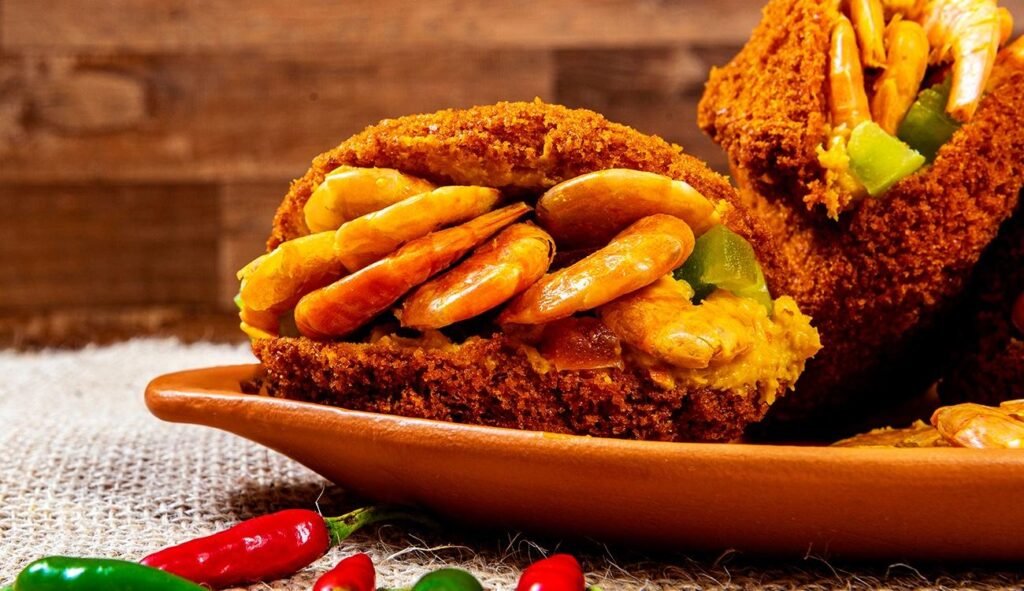
Brazilian cuisine is a delicious blend of cultural influences, and one dish that stands out is Acarajé. This dish has its origins in the African cuisine brought over by enslaved people to Brazil and is now a popular street food. In this blog post, we will explore the history of Acarajé and provide a recipe for you to try at home. History of Acarajé Acarajé has its roots in the West African country of Nigeria. The dish was brought over to Brazil during the slave trade era and became a popular street food in the northeastern state of Bahia. It is a deep-fried fritter made from black-eyed peas and stuffed with a flavorful mixture of shrimp, onions, peppers, and other spices. The dish is also an important part of the Candomblé religion, which is a syncretic religion that developed in Brazil during the 19th century. Acarajé is considered a sacred food and is often used as an offering to the deities. Recipe for Acarajé Acarajé Ingredients: Acarajé Instructions: Acarajé Cooking Time: The total cooking time for Acarajé is approximately 1 hour. Conclusion for Acarajé Acarajé is a delicious and flavorful dish that is deeply rooted in Brazilian culture and history. Its unique blend of African and Brazilian influences has made it a popular street food in Brazil and beyond. With this recipe, you can now recreate the flavors of Acarajé in your own kitchen and experience the tastes of this iconic dish for yourself. So, the next time you want to indulge in a delicious and unique street food, make sure to try Acarajé. More Latin American Recipes More Brazilian Recipes Follow Us on Instagram
Indulge in the Tastes of Brazil with the Iconic Caipirinha Cocktail

Brazil is known for its rich culture, diverse cuisine, and delicious cocktails. One such cocktail that has gained global popularity is the Caipirinha. This iconic drink is made with Brazil’s national spirit, Cachaça, and is the perfect refreshment for any occasion. In this blog post, we will explore the history of Caipirinha and provide a recipe for you to try at home. History of Caipirinha The origins of Caipirinha can be traced back to the 16th century when the Portuguese began to cultivate sugar cane in Brazil. This led to the production of Cachaça, a distilled spirit made from fermented sugar cane juice. Initially, Cachaça was used for medicinal purposes, but it soon became a popular drink among the working class in Brazil. The first recorded recipe for Caipirinha dates back to the early 20th century, and it was originally made with lime, sugar, and Cachaça. The drink gained popularity in the 1950s and 1960s when it was marketed as a national drink of Brazil. Today, Caipirinha is enjoyed all over the world, and its popularity shows no signs of slowing down. Recipe for Caipirinha Caipirinha Ingredients: Caipirinha Instructions: Caipirinha Cooking Time: The total cooking time for Caipirinha is approximately 5 minutes. Caipirinha Conclusion Caipirinha is a refreshing and delicious cocktail that perfectly represents the flavors of Brazil. Its simple yet flavorful recipe has made it a popular drink all over the world, and it is now a staple in many bars and restaurants. With this recipe, you can now recreate the flavors of Brazil in the comfort of your own home and experience the tastes of this iconic cocktail for yourself. So, the next time you want to indulge in a delicious and refreshing drink, make sure to try Caipirinha. More Latin American Recipes More Brazilian Recipes More Cocktails Recipes Follow Us on Instagram
Experience the Flavors of Brazil with Delicious Churrasco
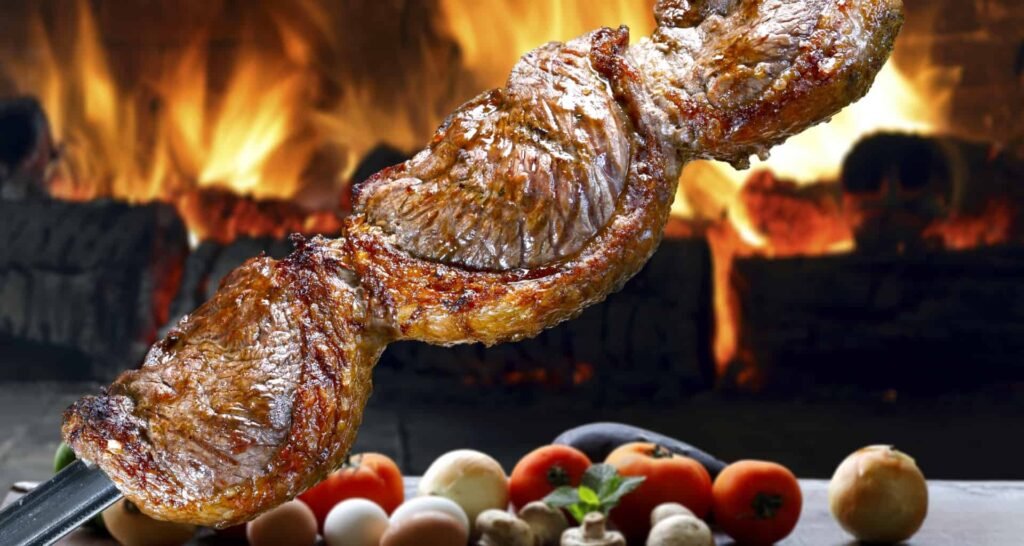
Brazilian Churrasco is a style of cooking that originated in the southern regions of Brazil and is now popular all over the country. This style of cooking is centered around the churrasqueira, a traditional grill that is used to cook a variety of meats to perfection. In this blog post, we will explore the history of Brazilian Churrasco and provide a recipe for you to try at home. History of Brazilian Churrasco Churrasco has its roots in the gaucho culture of southern Brazil, where cattle ranching was the primary industry. The gauchos, or cowboys, would gather around a fire and cook meat on skewers over an open flame, giving birth to the traditional Brazilian Churrasco. Over time, Churrasco evolved to include a wider variety of meats, including pork, chicken, and lamb, and became a popular way to celebrate special occasions such as weddings and family gatherings. Today, Churrasco is a staple in Brazilian cuisine and can be found in restaurants and homes all over the country. Recipe for Brazilian Churrasco Brazilian Churrasco Ingredients: Brazilian Churrasco Instructions: Brazilian Churrasco Cooking Time: The total cooking time for Brazilian Churrasco is approximately 30 minutes, with 15 minutes of active cooking time. Brazilian Churrasco Conclusion Brazilian Churrasco is a delicious and unique way of cooking that has become a staple in Brazilian cuisine. Its simple yet flavorful approach to grilling meats over an open flame is perfect for any occasion, from a casual backyard barbecue to a formal family gathering. With this recipe, you can now recreate the flavors of Brazilian Churrasco in the comfort of your own home and experience the tastes of Brazil for yourself. More Latin American Recipes More Brazilian Recipes Follow Us on Instagram
Discovering the Deliciousness of Brazilian Bobó de Camarão
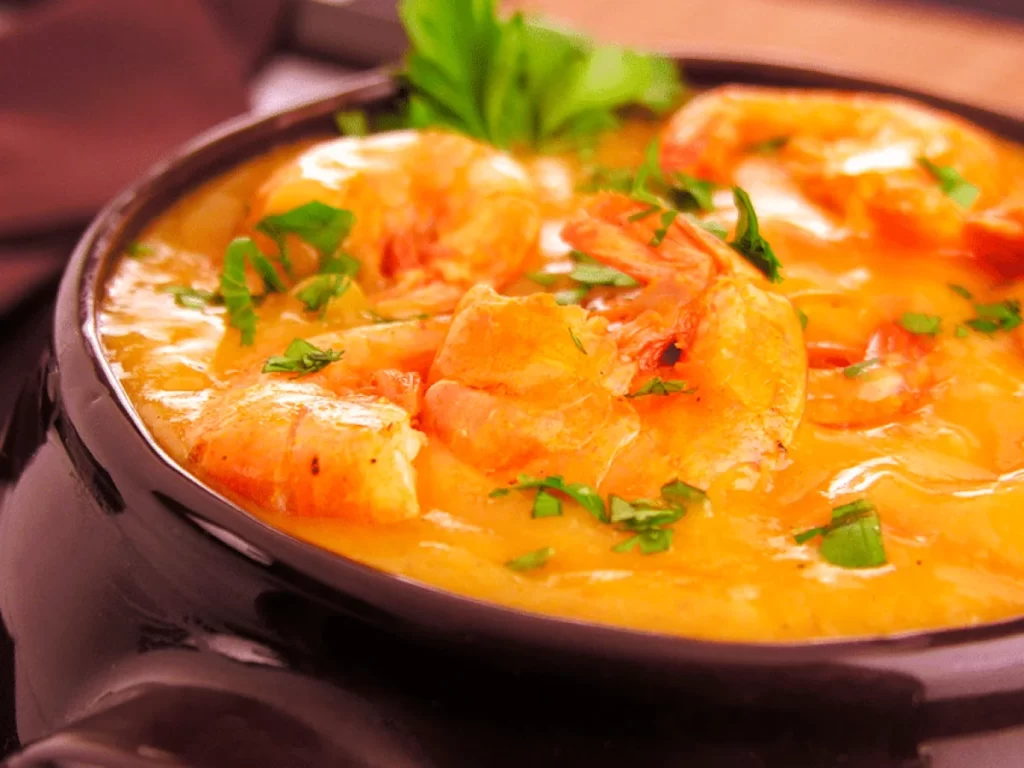
Brazilian cuisine is known for its vibrant flavors and unique combinations, and one dish that perfectly encapsulates this is the Bobó de Camarão. This creamy seafood stew is a favorite in Brazil and is made with fresh shrimp, cassava, coconut milk, and a variety of other ingredients. In this blog post, we will dive into the history and recipe of this delicious Brazilian dish. History of Bobó de Camarão Bobó de Camarão has its roots in the state of Bahia, located in northeastern Brazil. The dish has its origins in the Afro-Brazilian community and was influenced by African and indigenous cultures. Cassava, one of the main ingredients in the dish, was a staple crop in the indigenous communities of Brazil, while the addition of coconut milk was influenced by the African culture. Over time, the dish evolved and became popular throughout Brazil. Today, Bobó de Camarão can be found on menus in restaurants all over the country and is enjoyed by locals and tourists alike. Recipe for Bobó de Camarão Bobó de Camarão Ingredients: Bobó de Camarão Instructions: Bobó de Camarão Cooking Time: The total cooking time for Bobó de Camarão is approximately 1 hour and 15 minutes, with 35 minutes of active cooking time. Bobó de Camarão Conclusion Bobó de Camarão is a delicious and unique dish that perfectly showcases the flavors of Brazilian cuisine. Its creamy texture, fresh seafood, and blend of spices make it a must-try for anyone interested in exploring the diverse and vibrant flavors of Brazil. With this recipe, you can now make this classic dish in the comfort of your own home and experience the tastes of Brazil for yourself. More Latin American Recipes More Brazilian Recipes Follow Us on Instagram
Exploring the Delightful World of Brazilian Pão de Queijo
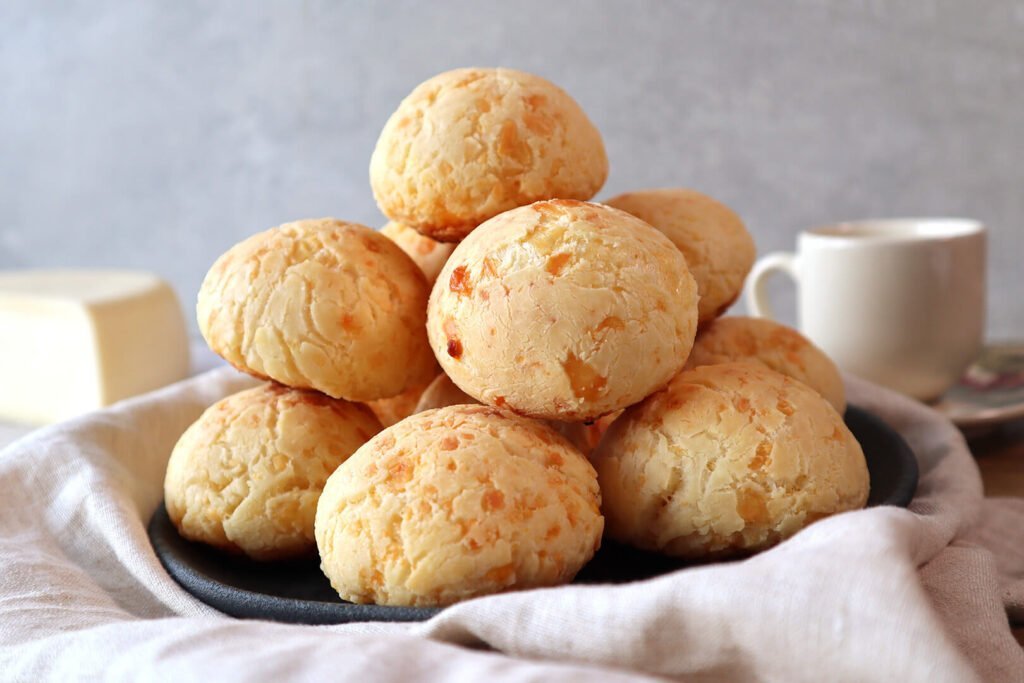
Brazilian cuisine is known for its rich and diverse flavors, and one of its most beloved dishes is pão de queijo. This delicious snack, which translates to “cheese bread” in English, is a popular street food in Brazil and has gained a following around the world. In this post, we’ll dive into the history of pão de queijo, explore its flavor profile, and provide you with a recipe to make it at home. History of Pão de Queijo Pão de queijo is believed to have originated in the Brazilian state of Minas Gerais in the 18th century. The dish was created by African slaves who used cassava starch, which was abundant in the region, to make a simple bread. The recipe evolved over time, and cheese was eventually added to the mix to create the delicious snack that we know and love today. Pão de queijo quickly became popular throughout Brazil and is now a staple in Brazilian cuisine. It’s commonly served as a snack or breakfast item, and can be found in bakeries, cafes, and street vendors throughout the country. In recent years, pão de queijo has gained a global following and is now enjoyed in many other countries around the world. Pão de Queijo Flavor Profile Pão de queijo is a unique and flavorful snack that combines the savory taste of cheese with the subtle sweetness of cassava starch. The bread has a crispy exterior and a soft and chewy interior, making it a delightful combination of textures. The cheese used in pão de queijo can vary, but traditionally, it’s made with queijo minas, a mild and creamy cheese that is also from the Minas Gerais region. Pão de queijo also has a slightly tangy flavor due to the addition of sourdough, which is used to give the bread its characteristic texture. The bread is typically served warm, which enhances the flavor and makes it even more enjoyable. Pão de Queijo Recipe and Cooking Time Now that you know a bit more about the history and flavor of pão de queijo, let’s dive into a recipe that you can make at home. Here’s what you’ll need: Pão de Queijo Ingredients: Pão de Queijo Instructions: The cooking time for pão de queijo is relatively quick, making it a great snack to whip up for a last-minute gathering or as an afternoon treat. The recipe we’ve provided makes about 30 pão de queijo balls, so it’s perfect for sharing with friends and family. In conclusion for Pão de Queijo Pão de queijo is a delicious and unique snack that has become a staple in Brazilian cuisine. Its history, flavor profile, and popularity have made it a beloved snack around the world. With this recipe, you can now enjoy the flavors of Brazil in the comfort of your own home. When it comes to serving pão de queijo, the possibilities are endless. You can enjoy them on their own as a snack or pair them with coffee for a delicious breakfast. Pão de queijo can also be served as an appetizer or side dish, and can be paired with a variety of dips or sauces. In Brazil, it’s common to see pão de queijo served with coffee or açaí bowls. The snack is also often served at parties and gatherings, where it’s enjoyed by both children and adults alike. In recent years, pão de queijo has become increasingly popular around the world. You can now find pão de queijo in specialty food stores and Brazilian restaurants in many countries. The snack has even gained a following on social media, with food bloggers and influencers sharing their own unique takes on the classic recipe. In conclusion, pão de queijo is a delicious and unique snack that has become a beloved staple in Brazilian cuisine. Its history, flavor profile, and popularity make it a must-try for anyone interested in exploring the flavors of Brazil. So why not try making a batch at home and enjoy the taste of Brazil in the comfort of your own kitchen? More Latin American Recipes More Brazilian Recipes Follow Us on Instagram
Brazilian Moqueca: A Hearty and Flavorful Seafood Stew
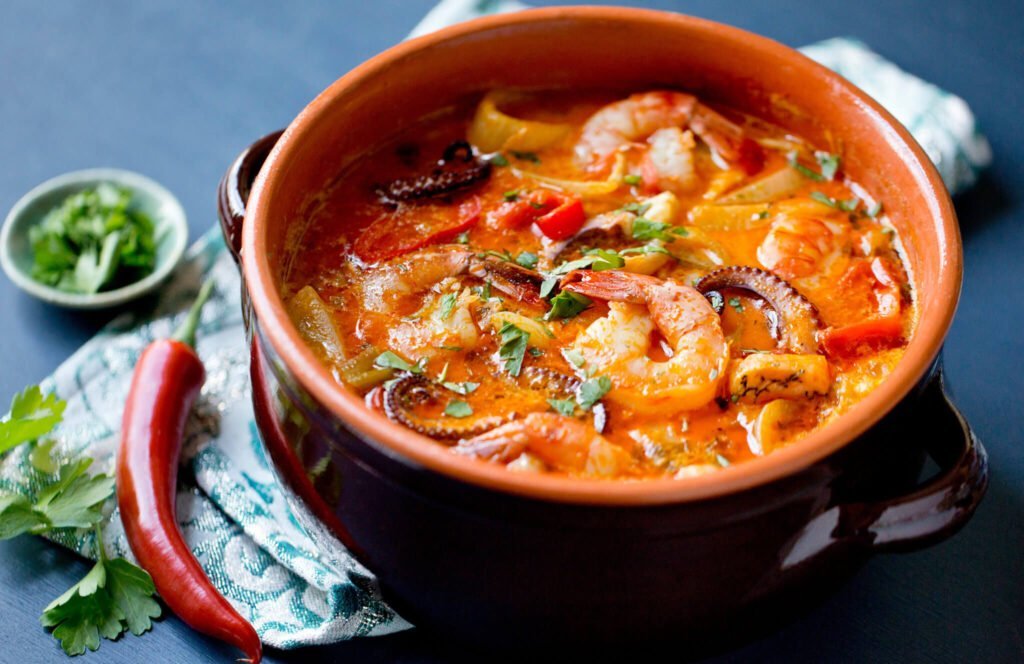
If you’re a fan of seafood, you’ve probably heard of Brazilian moqueca. This flavorful stew is a staple of Brazilian cuisine, and is made with fish, shrimp, or a combination of both, along with vegetables, coconut milk, and spices. In this blog post, we will explore the history of moqueca, the recipe, and how to make it in your own kitchen. History of Brazilian Moqueca Moqueca is a dish that originated in the northeastern state of Bahia in Brazil. It is believed to have been brought to Brazil by African slaves, and has since become a popular dish throughout the country. There are two main types of moqueca: moqueca baiana, which is made with dendê oil (palm oil), and moqueca capixaba, which is made with olive oil. Both types are delicious, but the use of dendê oil gives moqueca baiana a distinct and flavorful taste. Recipe for Brazilian Moqueca Moqueca Ingredients: Moqueca Instructions: Cooking Time for Brazilian Moqueca The cooking time for moqueca can vary depending on the type of seafood you use and the size of the chunks. In general, you’ll want to cook the fish for about 5-7 minutes, and the shrimp for about 3-4 minutes. The sauce should cook for about 10-15 minutes, until it has thickened and the seafood is fully cooked. It’s important to keep an eye on the seafood as it cooks, as overcooking can make it tough and rubbery. Moqueca Conclusion Brazilian moqueca is a hearty and flavorful seafood stew that is loved by Brazilians and seafood lovers around the world. With its combination of fish, shrimp, vegetables, and spices, it’s the perfect dish for any occasion. Whether you’re looking for a hearty meal for a chilly night or a delicious dinner party dish, moqueca is a great choice. So grab some fresh seafood, coconut milk, and spices, and try making this delicious Brazilian dish in your own kitchen. It’s a great way to explore new flavors and cuisines, and share it with friends and family. As with any recipe, there are variations of moqueca that you can try. Some people like to add dendê oil for a more traditional flavor, while others prefer to use olive oil for a milder taste. You can also experiment with different types of seafood, or add additional vegetables to the stew. In Brazil, moqueca is often served with rice and farofa, which is a toasted cassava flour that is commonly used as a side dish in Brazilian cuisine. This combination of flavors and textures is sure to delight your taste buds and satisfy your appetite. In conclusion, Brazilian moqueca is a dish that is steeped in tradition and history, and is beloved by people all over the world. With its rich blend of seafood, vegetables, and spices, it’s the perfect dish for any occasion, whether you’re hosting a dinner party or simply looking for a hearty and flavorful meal. So why not try making moqueca in your own kitchen today? You won’t regret it! More Latin American Recipes More Brazilian Recipes Follow Us on Instagram
Brazilian Coxinha: A Delicious and Savory Snack
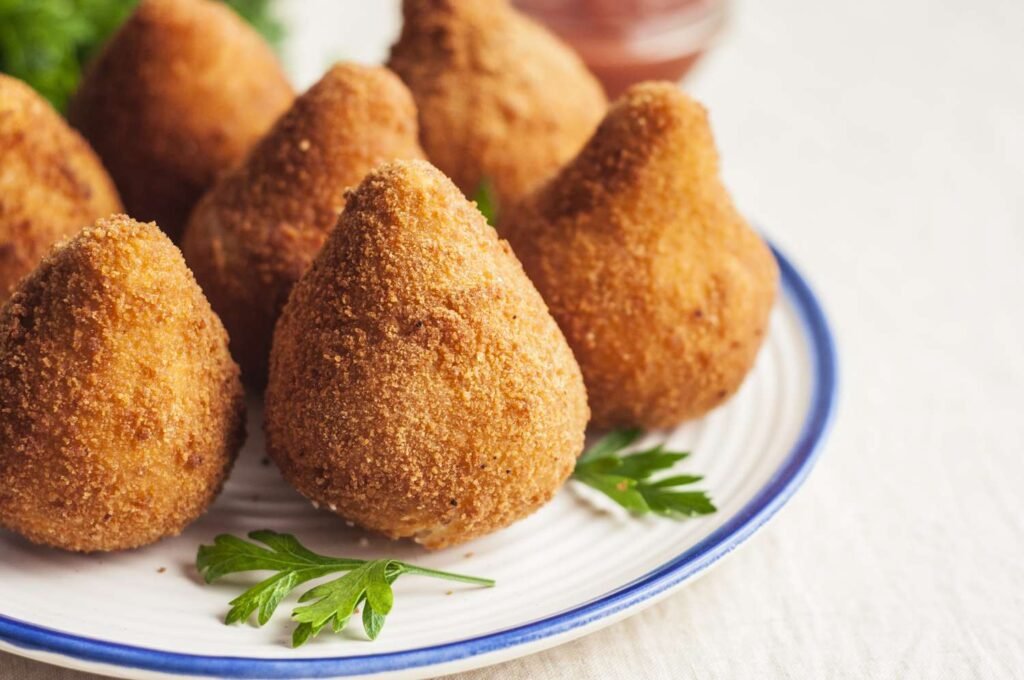
If you’re looking for a tasty and satisfying snack, look no further than Brazilian coxinha. These teardrop-shaped fritters are made with shredded chicken and spices, and are a favorite among Brazilians and food lovers around the world. In this blog post, we will explore the history of coxinha, the recipe, and how to make them in your own kitchen. History of Brazilian Coxinha Coxinha is a popular snack in Brazil, and is often eaten as a street food or at parties and celebrations. It is believed to have originated in the state of São Paulo, and has been a staple of Brazilian cuisine for over a century. The name coxinha means “little thigh” in Portuguese, and refers to the teardrop shape of the fritter, which is meant to resemble a chicken thigh. Coxinha is traditionally made with shredded chicken, spices, and a dough made with flour, milk, and butter. The dough is shaped into a teardrop shape, filled with the chicken mixture, and then breaded and deep-fried. Today, there are many variations of coxinha, including vegetarian and cheese-filled versions. Recipe for Brazilian Coxinha Brazilian Coxinha Ingredients: Brazilian Coxinha Instructions: Cooking Time for Brazilian Coxinha The cooking time for coxinha can vary depending on the size of the fritters and the heat of the oil. In general, they should be fried until they are golden brown and crispy, which takes about 3-5 minutes. It’s important to make sure the oil is hot enough before frying the coxinha, as this will help them cook evenly and prevent them from becoming greasy. Brazilian Coxinha Conclusion Brazilian coxinha is a delicious and savory snack that is loved by Brazilians and food lovers around the world. With its teardrop shape and flavorful filling, it’s the perfect snack for any occasion. Whether you’re looking for a tasty street food or a delicious party snack, coxinha is a great choice. So why not try making them in your own kitchen today? More Latin American Recipes More Brazilian Recipes Follow Us on Instagram
Brazilian Brigadeiros: A Delicious Treat for Any Occasion
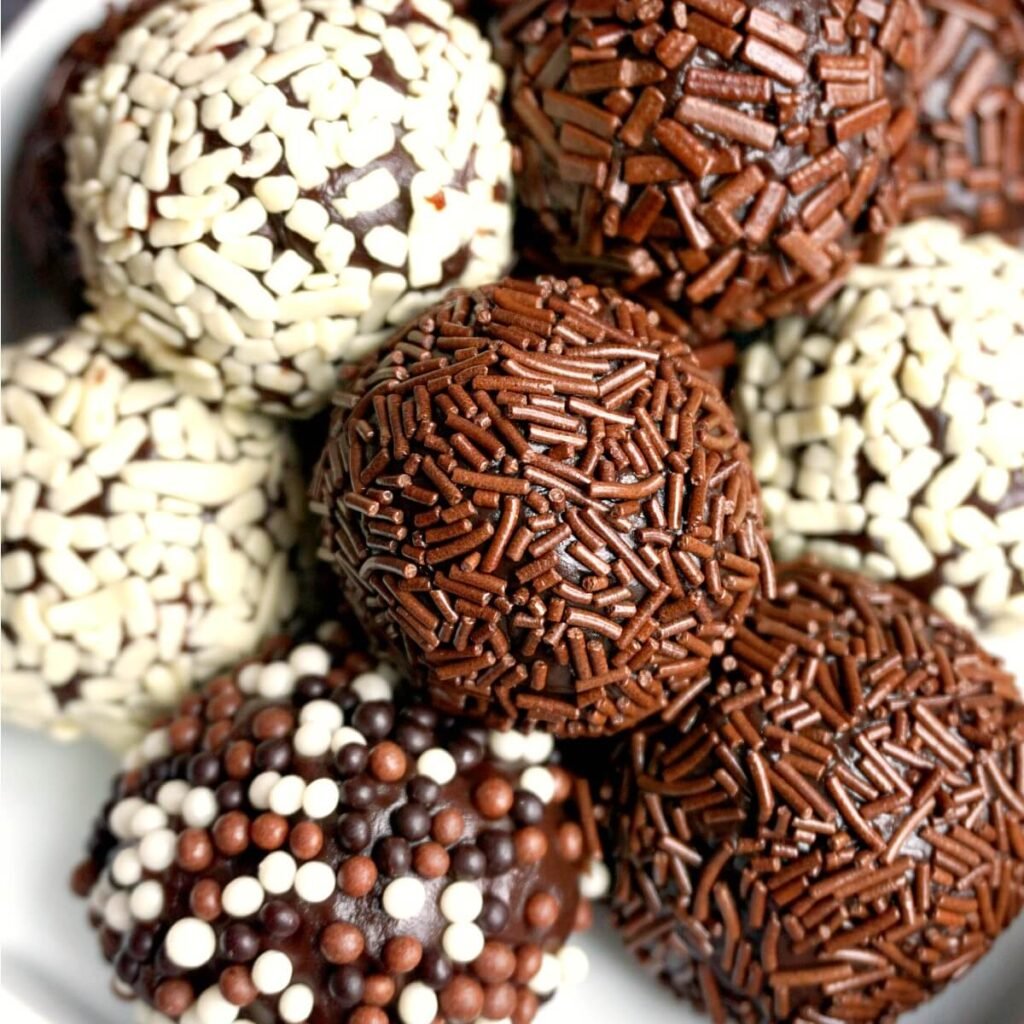
Brazilian brigadeiros are a classic and delicious sweet treat that is enjoyed by people of all ages in Brazil and around the world. These small chocolate balls are a staple at parties and celebrations, and are a favorite among children and adults alike. In this blog post, we will explore the history of brigadeiros, the recipe, and how to make them in your own kitchen. History of Brazilian Brigadeiros The brigadeiro was first created in the 1940s, during Brazil’s campaign for a new president. One of the candidates was Brigadeiro Eduardo Gomes, a well-known air force brigadier general. His supporters wanted to create a dessert in his honor, and thus the brigadeiro was born. It quickly became a popular treat in Brazil, and is now a staple at birthday parties, weddings, and other celebrations. Brigadeiros are easy to make and require only a few simple ingredients. Traditionally, they are made with condensed milk, cocoa powder, butter, and chocolate sprinkles. However, there are now many variations of brigadeiros, including white chocolate, pistachio, and coconut. Recipe for Brazilian Brigadeiros Brigadeiros Ingredients: Brigadeiros Instructions: Cooking Time for Brazilian Brigadeiros The cooking time for brigadeiros can vary depending on the heat of your stove and the thickness of the mixture. However, in general, it should take around 10-15 minutes to cook the mixture over medium heat. It’s important to stir the mixture constantly to prevent it from burning or sticking to the pan. Once the mixture thickens and starts to pull away from the sides of the pan, it’s ready to be removed from the heat. Brigadeiros Conclusion Brazilian brigadeiros are a delicious and easy-to-make sweet treat that is enjoyed by people of all ages. With just a few simple ingredients and a little bit of time, you can create these small chocolate balls that are perfect for any occasion. Whether you’re celebrating a birthday, a wedding, or just want a sweet treat to enjoy with your family and friends, brigadeiros are a great choice. So why not try making them in your own kitchen today? More Latin American Recipes More Brazilian Recipes Follow Us on Instagram
